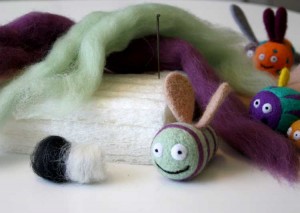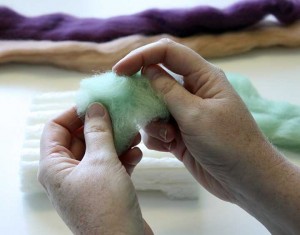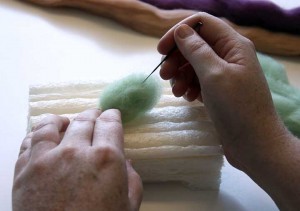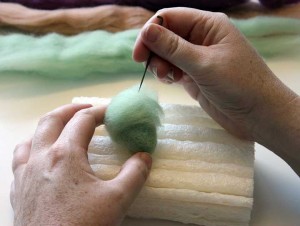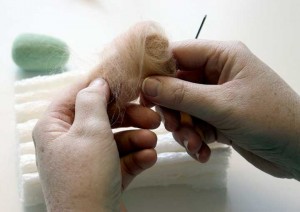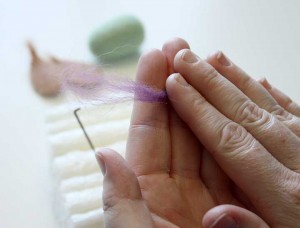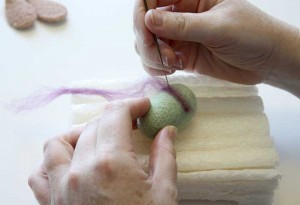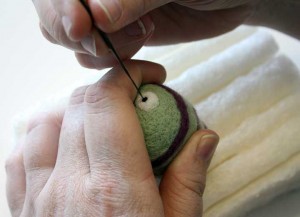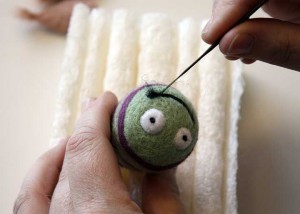Little Bugger
Before you start, you need to know:
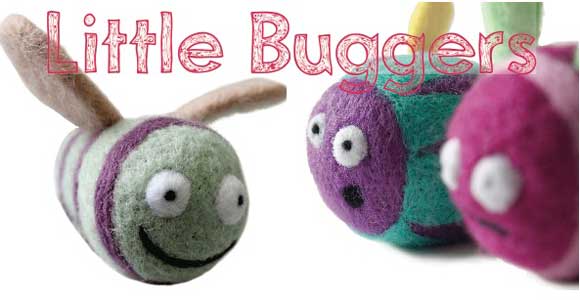
Felting needles are sharper than the sharpest sharp thing you can think of. While felting, always watch your hands and fingers to avoid boo-boos. Make sure your pokes are gentle, too.
Ready? Ok!
|
|
Materials and Tools:
Foam, 1 felting needle, and wool fiber – colors: 3 of your choice + Black, and White (colors in photos are Shamrock Shake, Lilac-alicious, and Sand)
1. Pull the fiber
Start with a tuft of your base color about 6” long. (The fiber pulls apart more easily if you place your hands about 4-5 inches apart and pull gently.)
|
|
2. Loosen the fiber
Loosen the tuft a bit, pulling the sides to flatten the fiber and make it wispy.
|
|
3. Fold and roll the fiber
Fold the fiber and roll loosely into a not-at-all-perfect bullet-y log, approx. 2″ long.
|
|
4. Start your poking
Place the log on the foam and gently poke the needle into the fiber.
|
|
♥ ….
Bonus Tip for The People: Gentle pokes work best. The business end of the needle is only an inch at the tip. Poke any further than that and it’s a waste of your efforts.
…. ♥
|
|
5. Poke it all over
Use gentle pokes all over the log, rolling it along and moving it around the foam. (Moving it helps keep the log from permanently sticking to the foam.)
|
|
6. Add fiber
Once the log starts to hold the body shape and condense, take a thin tuft of fiber and wrap it up loosely.
|
|
7. Keep poking
Continue gently poking the body from all sides. If the body is about the right size but isn’t as thick or as strong as you’d like, pull a little more roving, loosely wrap it around the body and keep poking. Repeat as needed.
|
|
8. Embiggen the head
To make the head side of the log bigger than the tail, add small tufts of fiber to the area as needed and gently poke the body all over to incorporate new fiber and shape the head.
♥ ….
Zing! Check it… A Tip!: Even when you are poking at an angle, make sure your needle goes in and out in the same direction. Otherwise, it could snap.
…. ♥
|
|
9. Shape the body
Hold the bug body on its head end and gently poke the bottom of the body to refine the round shape. Flip it onto its tail end and poke the head to refine the shape (Repeat steps 6 & 7 as needed to make the whole log thicker.)
|
|
10. Winging it
Take a small wisp of fiber, loosen then fold it into a wing-y tuft.
|
|
11. Poke at the wing
Use very gentle pokes to begin building the wing thickness. Once it starts to thicken, flip the wing over and continue to poke and shape on the other side. Repeat a few times.
|
|
12. Add more fiber
Add a tiny bit of fiber to the wing (as you did for the body) and keep poking it into shape.
|
|
13. Shape the wing
Use gentle, shallow pokes on the wide end of the wing, rounding out the shape. Be sure to flip the wing often and refine both sides.
|
|
14. Shape the wing some more
Hold the wing on its side and use extremely gentle pokes to refine the edges of the wing, leaving the narrow end a little unfinished and fuzzy. Repeat steps 10 – 14 to make a second wing (or you can pretend that a mean child plucked your bug and then only one wing is necessary).
|
|
15. Embellish your bug body
Take a very small wisp of accent color fiber and roll it between your fingers into a thinish log.
|
|
16. Fly fashion forward – poke those stripes
Take the wispy log and use gentle pokes to begin tacking it to the surface of the bug body. Poke all the way around so the strip meets itself. Add extra fiber in very small wisps as needed to extend or thicken the stripe.
|
|
17. Refine your stripey-goodness
Use tiny pokes along the edge of the stripe to flatten and fine-tune the embellishment. Add more tiny bits of fiber and poke as needed. Repeat these stripey procedures until you have all the stripes one bug could ever want.
|
|
18. Bug-eyes!
Use a small wisp of white fiber and gently poke it into place to start an eye.
|
|
19. Shape the bug eye
Gently poke the edges of the eye under itself, towards its center. This will make it even more secure while creating a puffy shape. Use teeny-tiny pokes to further felt the surface of the eye without flattening it.
|
|
20. Eye see you
Take a teeny-weeny bit of black fiber and poke it into the center of the eyeball. Repeat steps 18 – 20 to make a second eye for your bug to use when he learns to read.
|
|
21. Mouthy
Take a small wisp of black and poke it into the face wherever you think it should go. (This is the same technique you used for the buggy stripes, but smaller and in your bug-face!)
|
|
22. Attach the wing
With the bug body on the foam, hold a wing in place and gently poke the fuzzy end into the body wherever you think it goes.
|
|
23. Even more poking
Poke the wing on all sides of the body. Repeat step 22 with the second wing. Add a small wisp of fiber if needed to make sure the wings are permanently attached.
|
|
